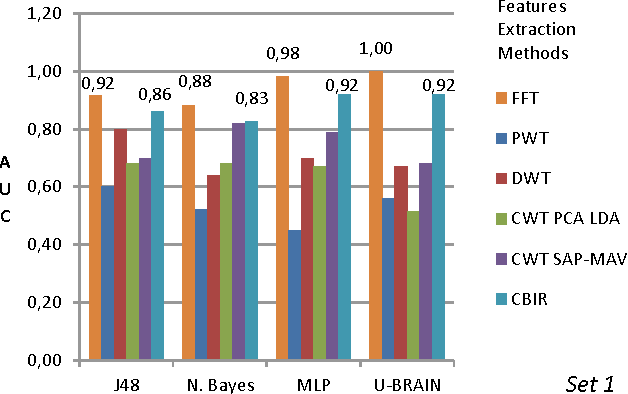Gianni D'Angelo
Feature Extraction and Soft Computing Methods for Aerospace Structure Defect Classification
Nov 15, 2016



Abstract:This study concerns the effectiveness of several techniques and methods of signals processing and data interpretation for the diagnosis of aerospace structure defects. This is done by applying different known feature extraction methods, in addition to a new CBIR-based one; and some soft computing techniques including a recent HPC parallel implementation of the U-BRAIN learning algorithm on Non Destructive Testing data. The performance of the resulting detection systems are measured in terms of Accuracy, Sensitivity, Specificity, and Precision. Their effectiveness is evaluated by the Matthews correlation, the Area Under Curve (AUC), and the F-Measure. Several experiments are performed on a standard dataset of eddy current signal samples for aircraft structures. Our experimental results evidence that the key to a successful defect classifier is the feature extraction method - namely the novel CBIR-based one outperforms all the competitors - and they illustrate the greater effectiveness of the U-BRAIN algorithm and the MLP neural network among the soft computing methods in this kind of application. Keywords- Non-destructive testing (NDT); Soft Computing; Feature Extraction; Classification Algorithms; Content-Based Image Retrieval (CBIR); Eddy Currents (EC).
Diagnosis of aerospace structure defects by a HPC implemented soft computing algorithm
Oct 18, 2016


Abstract:This study concerns with the diagnosis of aerospace structure defects by applying a HPC parallel implementation of a novel learning algorithm, named U-BRAIN. The Soft Computing approach allows advanced multi-parameter data processing in composite materials testing. The HPC parallel implementation overcomes the limits due to the great amount of data and the complexity of data processing. Our experimental results illustrate the effectiveness of the U-BRAIN parallel implementation as defect classifier in aerospace structures. The resulting system is implemented on a Linux-based cluster with multi-core architecture.
* 5 pages, IEEE International Workshop on Metrology for Aerospace
Shape-based defect classification for Non Destructive Testing
Oct 18, 2016



Abstract:The aim of this work is to classify the aerospace structure defects detected by eddy current non-destructive testing. The proposed method is based on the assumption that the defect is bound to the reaction of the probe coil impedance during the test. Impedance plane analysis is used to extract a feature vector from the shape of the coil impedance in the complex plane, through the use of some geometric parameters. Shape recognition is tested with three different machine-learning based classifiers: decision trees, neural networks and Naive Bayes. The performance of the proposed detection system are measured in terms of accuracy, sensitivity, specificity, precision and Matthews correlation coefficient. Several experiments are performed on dataset of eddy current signal samples for aircraft structures. The obtained results demonstrate the usefulness of our approach and the competiveness against existing descriptors.
* 5 pages, IEEE International Workshop
 Add to Chrome
Add to Chrome Add to Firefox
Add to Firefox Add to Edge
Add to Edge